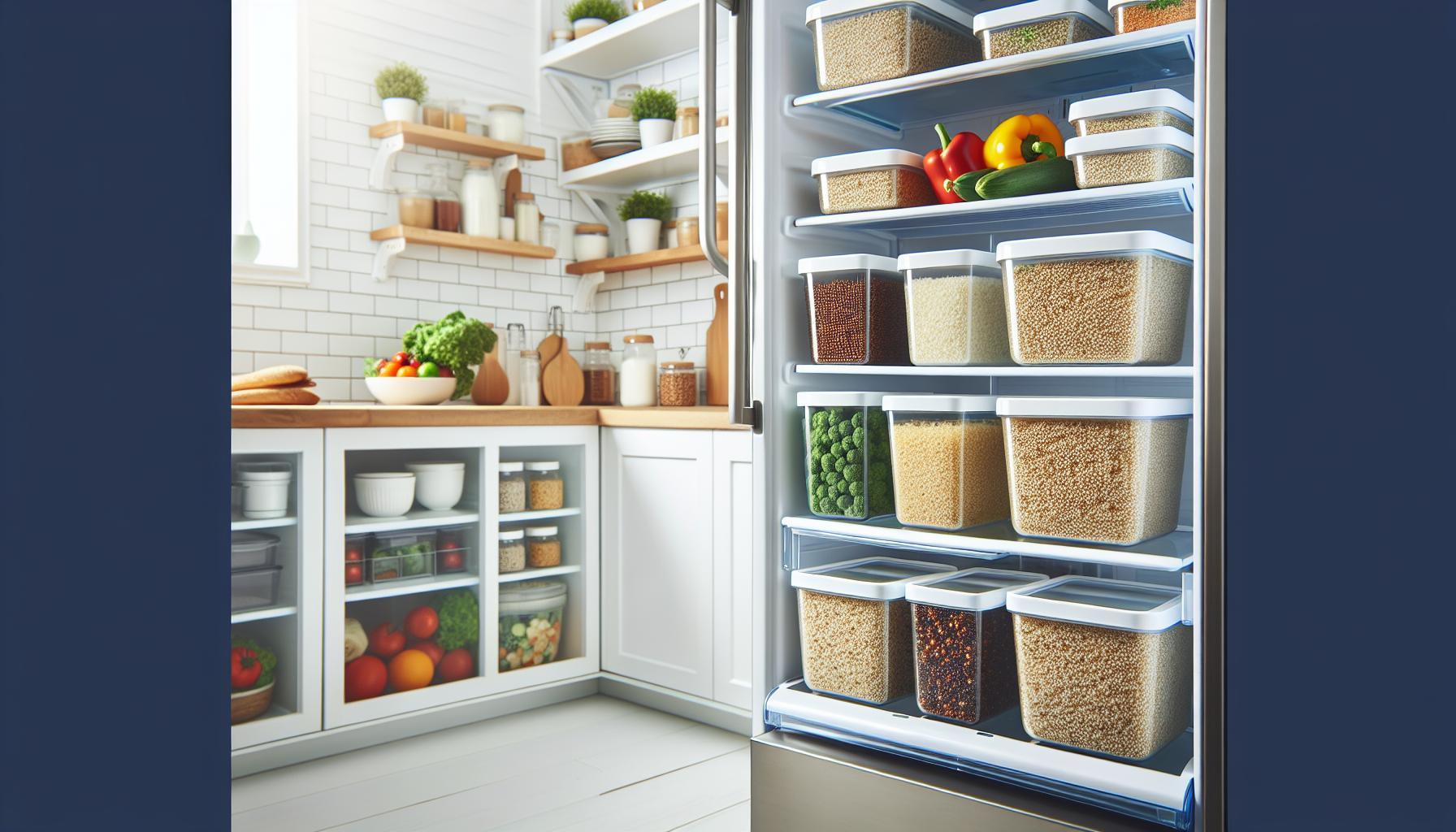Quinoa, often hailed as a superfood, is not only rich in protein and essential nutrients but also incredibly versatile for meal prep. However, knowing how long it lasts in the fridge is crucial to avoid waste and ensure food safety. Many home cooks face the dilemma of storing leftovers, wondering when it’s still safe to eat and when it’s best to toss it out.
Understanding quinoa’s fridge lifespan can help you maximize its benefits while minimizing food waste. This grain-like seed keeps well, but factors like cooking method and storage can affect its longevity. By following proper storage guidelines, you can confidently incorporate quinoa into your meal prep routine without fear of spoilage. Ready to learn how to extend the life of your quinoa dishes? Let’s dive into the essential tips!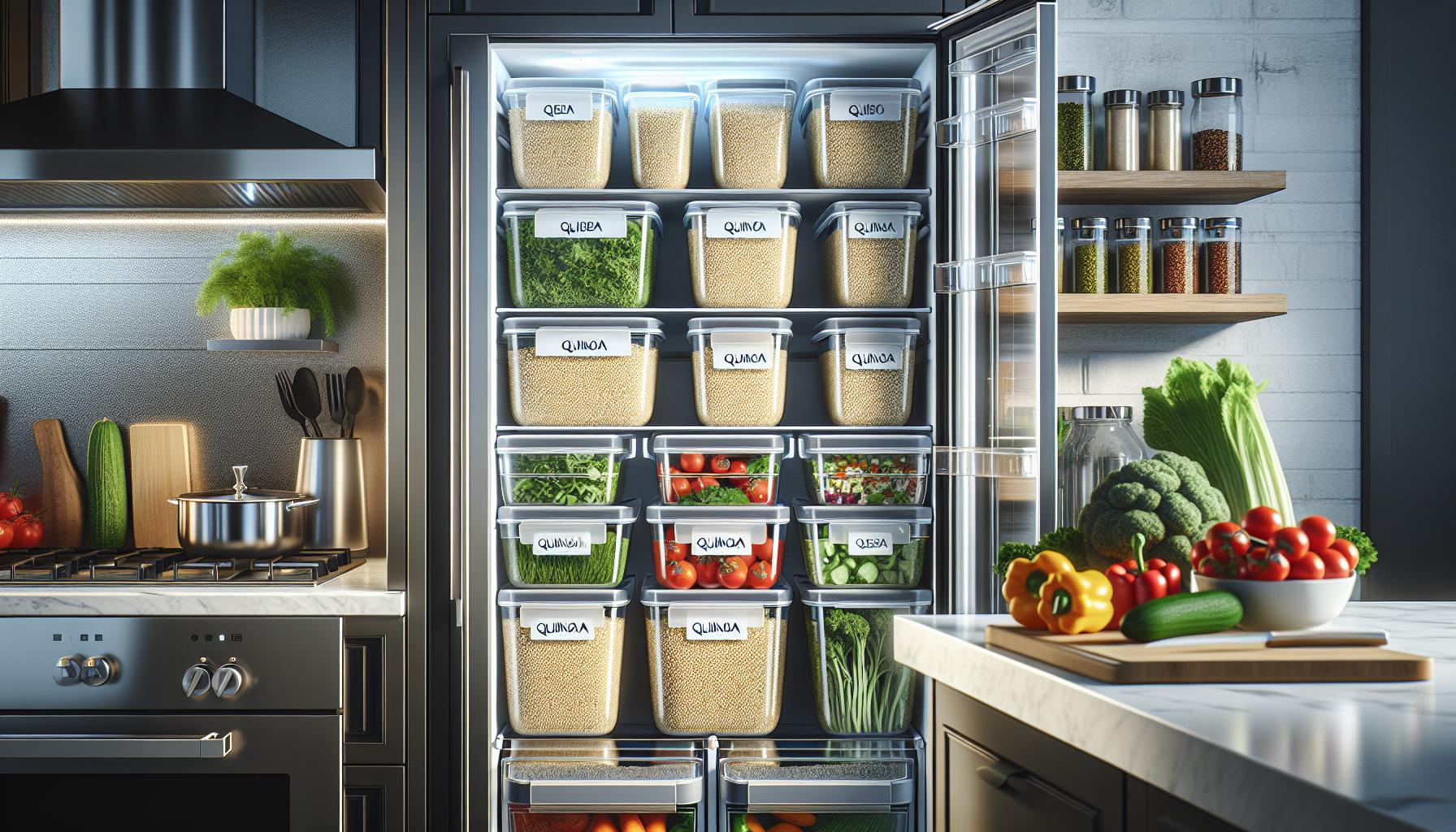
How Long Does Quinoa Last in the Fridge?
Quinoa, often touted as a superfood, is not just a nutritious option; it’s also quite versatile when it comes to meal preparation. When stored properly, cooked quinoa can last in the refrigerator for about 3 to 5 days. This short shelf life may seem limited, but with the right practices, you can make the most out of your quinoa meal prep.
To ensure your quinoa remains fresh and safe to eat, it’s crucial to cool it down quickly after cooking. Once cooled, transfer your quinoa to an airtight container; this reduces the risk of contamination and keeps moisture in. It’s also essential to label your container with the date to track freshness easily. If you’ve prepared a large batch and you’re not sure you’ll consume it all within the week, consider portioning it out into smaller containers for easy access and to minimize the amount of quinoa exposed to air each time you open the fridge.
Not only does proper storage extend the life of your quinoa, but it also preserves its nutritional benefits. Quinoa is a complete protein, packed with vitamins and minerals, making it a great choice for a healthy diet. By keeping your cooked quinoa at the correct temperature and in the right environment, you ensure every meal is not just safe to eat but also rich in the nutrients your body needs. If you notice any off-smell or texture changes, it’s best to err on the side of caution and discard the quinoa to prevent potential foodborne illness. Remember, a little attention to detail in storage can lead to delicious and convenient meals throughout the week.
Understanding Quinoa Storage Guidelines
Cooking quinoa offers a myriad of health benefits and a versatile grain option for meal prep enthusiasts. To ensure that you savor every nutritious bite while minimizing food waste, it’s essential to understand the correct storage guidelines for both cooked and uncooked quinoa.
Once quinoa is cooked, it should be stored correctly to maximize freshness and safety. Ideally, cooked quinoa can last in the fridge for 3 to 5 days. To achieve this, wait for the quinoa to cool down to room temperature post-cooking-this helps prevent condensation, which can lead to spoilage. Transfer the cooled quinoa into an airtight container, making sure it’s sealed completely to block out air and moisture. It’s a good practice to label your container with the date of preparation, as it makes tracking freshness easy and helps avoid unintentional consumption of expired food.
For uncooked quinoa, it can be stored in a cool, dry place, such as a pantry, and typically lasts for 2 to 3 years if kept in a sealed container away from sunlight. Factors like humidity and temperature can affect its shelf life, so it’s best to store it in a stable environment.
Here are some essential guidelines to help you store quinoa correctly:
- Cool Properly: Allow hot quinoa to cool to room temperature before placing it in storage containers.
- Airtight Containers: Use airtight storage to minimize moisture exposure and contamination.
- Labeling: Always label containers with the date to monitor how long it has been stored.
By adhering to these storage practices, you can enjoy the full range of quinoa’s nutritional benefits while ensuring it stays fresh and safe for your meals throughout the week. If you notice any unusual odors or changes in texture, it’s a clear sign that the quinoa has spoiled, and it’s best to discard it to ensure your safety.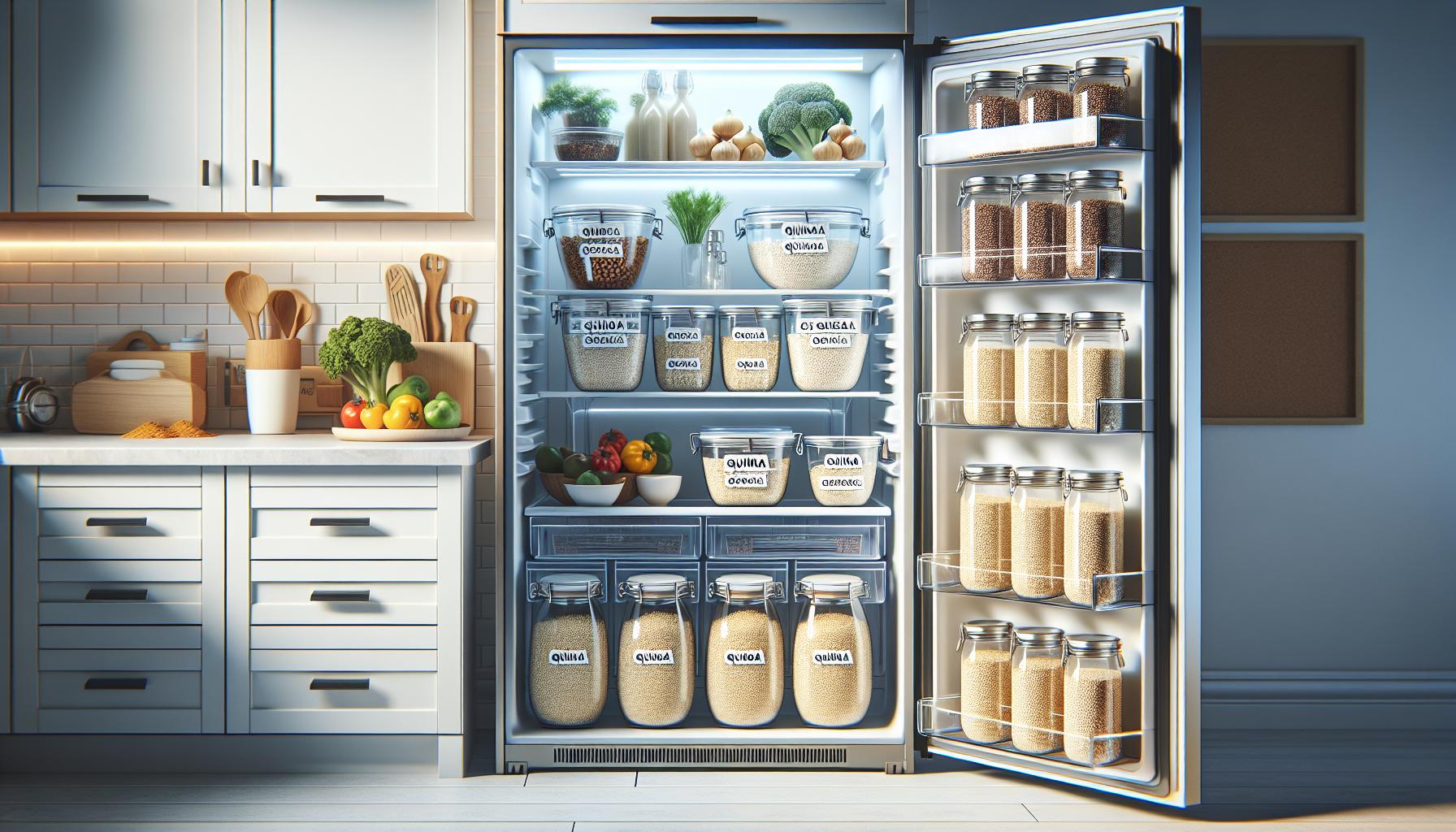
Signs of Spoiled Quinoa to Watch For
Understanding when quinoa has spoiled is crucial for both food safety and maintaining the quality of your meals. Freshly cooked quinoa is a nutritious addition to your diet, but it’s not invincible; it can go bad if not stored correctly. Keep an eye out for several signs that indicate your quinoa may have reached its expiration.
The most straightforward indicator that cooked quinoa has spoiled is a noticeable shift in smell. Fresh quinoa has a mild, nutty aroma, while spoiled quinoa can develop an unpleasant or sour odor. If the smell has changed significantly, it’s best to err on the side of caution and discard it. Additionally, pay attention to the texture. Fresh quinoa should be fluffy and slightly chewy, but if you notice it has become slimy or mushy, that’s a strong sign of spoilage. The presence of mold is another red flag; if you see any dark, fuzzy spots, throw the quinoa away immediately.
Always trust your senses when assessing food safety. If you’re unsure about the state of your quinoa, check for any discoloration, such as a dull appearance compared to its usual shine. While eating spoiled quinoa may not always lead to severe consequences, it’s better to prioritize your health and dispose of anything that shows signs of spoilage. By recognizing these signs early, you can avoid unnecessary waste and ensure that your meal prep remains safe and delicious.
Taking proactive steps in storage can increase the lifespan of your quinoa significantly. Enjoy your quinoa while it’s fresh by practicing good storage habits and being vigilant about freshness indicators.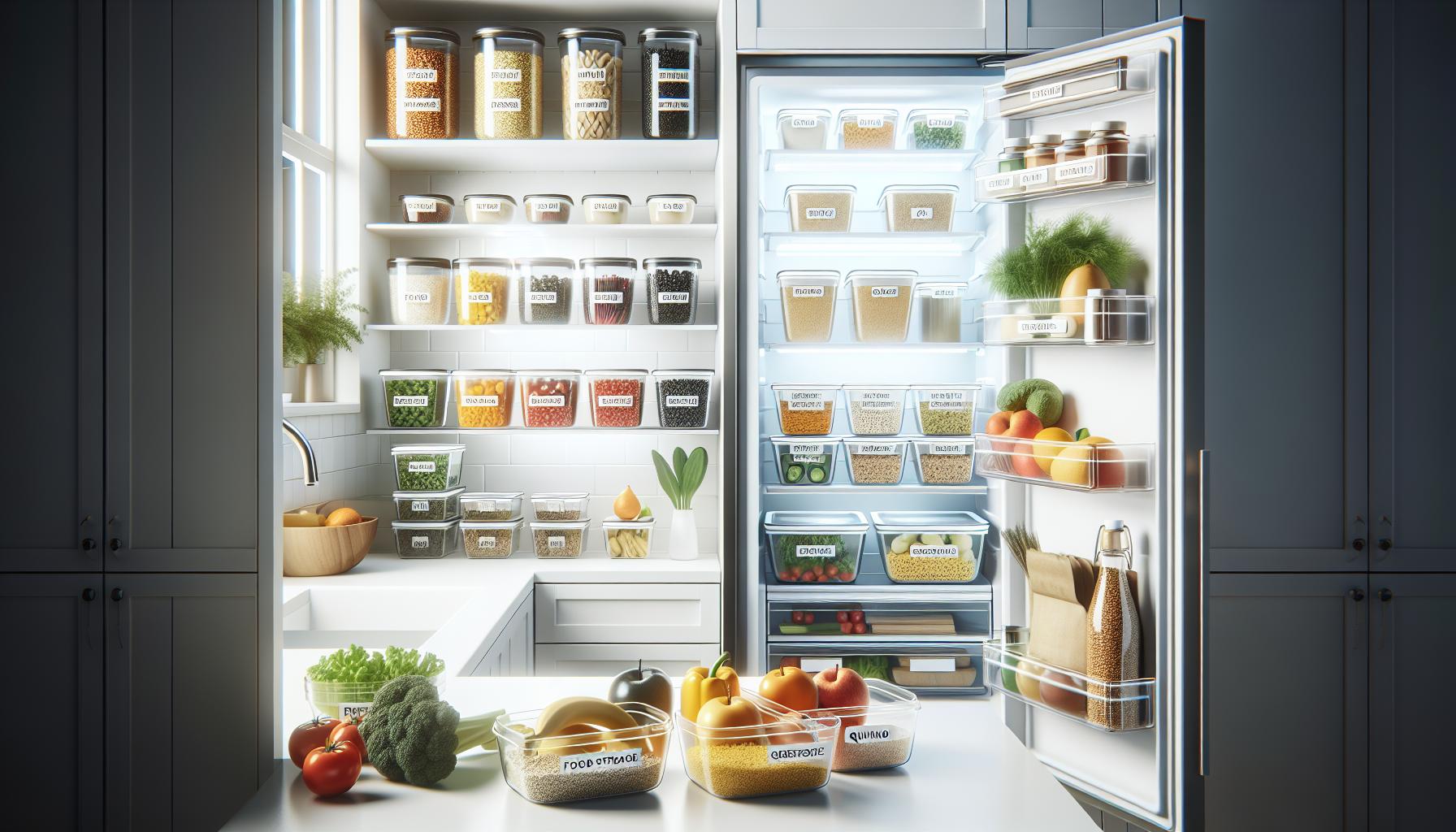
Best Practices for Meal Prep with Quinoa
Meal prepping with quinoa can elevate your cooking game, turning this nutritious seed into the star ingredient of your week. Quinoa, often praised for its protein content and versatility, can be prepped efficiently to ensure it stays fresh and delicious throughout the week. By adopting best practices in your meal prep routine, you can create wholesome meals while minimizing waste.
To start, always cook quinoa in batches. A typical serving is about 1/4 cup of dry quinoa per person, which expands to about three times that volume when cooked. Cooking larger quantities allows you to portion out individual servings to use throughout the week. Once cooked, quinoa can be stored in the fridge in an airtight container for up to five days. To maintain its fluffy texture, add a sprinkle of water before sealing the container, which helps prevent it from drying out.
When refrigerating cooked quinoa, separating it into smaller, single-serving portions can help with meal planning. This way, you can simply grab a portion as needed, reducing the temptation to eat it all at once and ensuring your leftovers stay fresh. Additionally, label each container with the date it was cooked to keep track of freshness. For those looking to extend the shelf life, consider freezing portions of cooked quinoa. It can be frozen for up to three months; just make sure to thaw it in the refrigerator overnight before use.
Be creative with your quinoa preparations. Utilize various flavor profiles by mixing in different vegetable options or proteins that align with your meal plan. For instance, Mediterranean quinoa with chickpeas, bell peppers, and a lemon-olive oil dressing is vibrant and full of flavor. Alternatively, spice it up with some Mexican-inspired ingredients like black beans, corn, and salsa for a dynamic twist. The key is to diversify your meals to keep your diet exciting while ensuring that you’re effectively utilizing your quinoa stash throughout the week.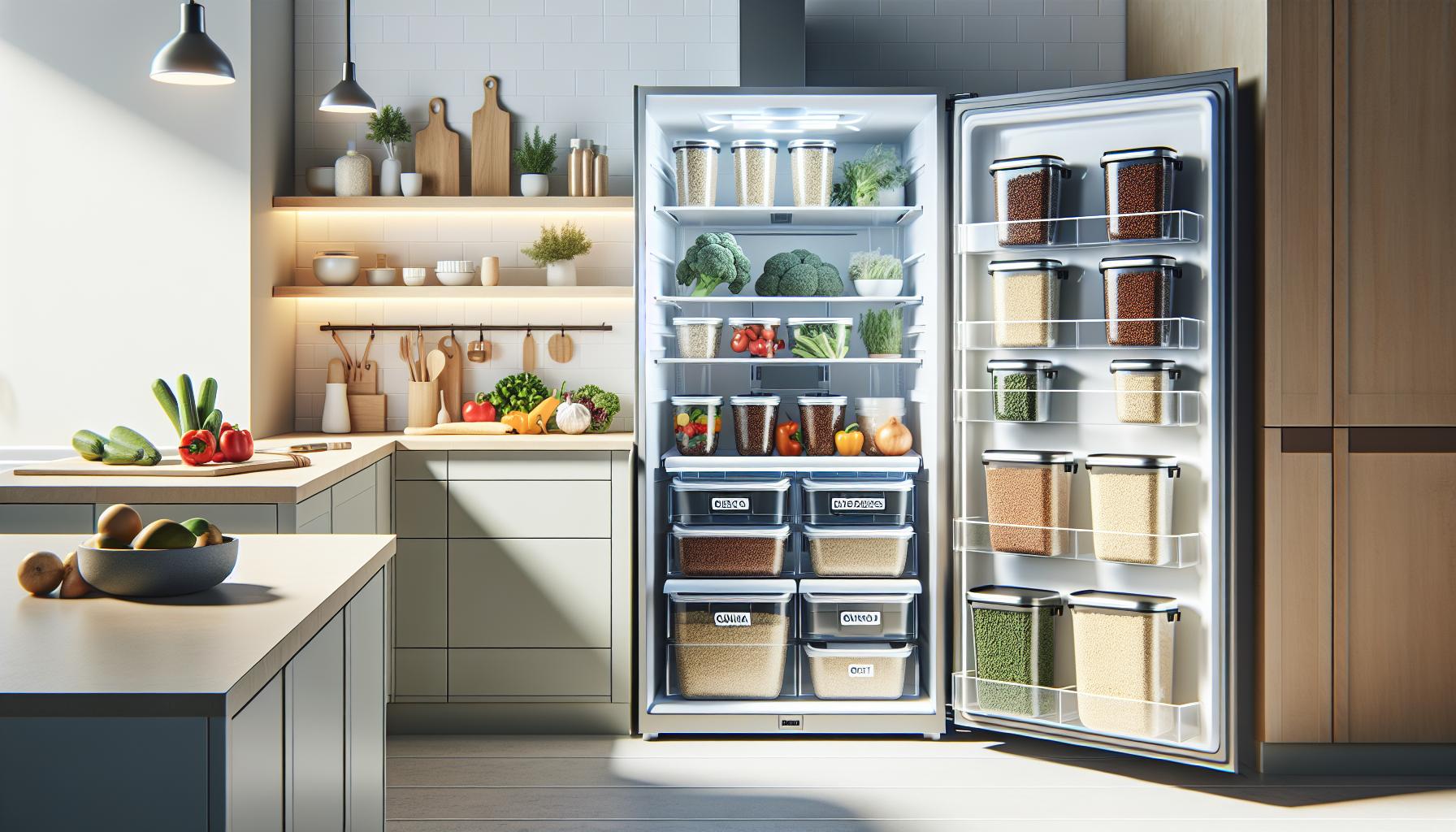
Freezing Quinoa: A Step-by-Step Guide
Freezing cooked quinoa is an excellent way to enhance its shelf life and make meal prep even more convenient. Not only can you preserve the nutritional integrity of this superfood, but you can also save time during busy weeks. With just a few simple steps, you can easily freeze portions of quinoa, ensuring they remain fresh and ready to use.
Begin by allowing your cooked quinoa to cool completely at room temperature. This is essential because freezing hot quinoa can create condensation, leading to ice crystals and a mushy texture upon thawing. Once cooled, portion the quinoa into individual servings. This practice not only makes it easier to thaw just what you need but also helps prevent waste. Consider using freezer-safe containers or resealable plastic bags-just be sure to remove as much air as possible to avoid freezer burn. Label each container or bag with the date and contents for easy identification later.
For an organized approach, you can set your freezer temp to 0°F (-18°C) or lower, which is optimal for maintaining food quality. Quinoa can be safely stored in the freezer for up to three months while maintaining its flavor and texture. When you’re ready to use it, simply transfer the desired portion to the refrigerator for an overnight thaw, or use the microwave for a quicker option. To reheat, add a splash of water or broth to ensure it heats evenly and stays moist.
Incorporating frozen quinoa into your meals is straightforward. You can stir it into soups, toss it in salads, or mix it with vegetables and spices for a quick, nutritious dish. By utilizing frozen quinoa, you can enjoy the health benefits of this versatile seed anytime without the worry of spoilage, making it a fantastic addition to your meal prep routine.
How to Reheat Quinoa Safely and Deliciously
To enjoy quinoa at its best after storage, reheating it properly is essential. Whether you’re using quinoa from your fridge or thawed from the freezer, the goal is to restore its fluffy texture and subtle flavor. The key is to ensure the grain does not dry out, so incorporating a bit of moisture during reheating is crucial.
Start by transferring your portioned quinoa into a microwave-safe bowl and add a splash of water or broth-approximately 1-2 tablespoons per cup of quinoa. This small amount of liquid will create steam during the reheating process, keeping the quinoa moist and preventing it from becoming rubbery. Cover the bowl with a microwave-safe lid or damp paper towel to trap the steam effectively, and microwave on high for about 1 to 2 minutes, or until heated through. Stir halfway through to distribute the heat evenly.
If you prefer stovetop reheating, add the quinoa to a small saucepan. Again, incorporate a splash of water or broth and cover the pot. Heat over low to medium heat, stirring occasionally until the quinoa is evenly warm. This method allows for greater control over the moisture content, ensuring that the quinoa does not stick to the pan or dry out.
For an added layer of flavor, consider incorporating some herbs, spices, or sautéed vegetables while reheating. This not only enhances the overall taste but also turns reheated quinoa into a delicious side dish or main meal. Following these reheating tips will ensure that each serving of quinoa is delightful, providing maximum enjoyment and a healthy addition to your meal prep.
Comparing Quinoa Storage Methods: Fridge vs. Freezer
When it comes to storing quinoa, your choice between the fridge and freezer can significantly impact its freshness and usability for meal prep. Understanding how each method affects quinoa can ensure you maximize both its flavor and nutritional value.
Quinoa stored in the refrigerator can last approximately 3 to 5 days. This method is ideal if you plan to consume your quinoa relatively quickly. To store cooked quinoa, allow it to cool completely, then transfer it to an airtight container. This prevents moisture from leading to spoilage and ensures that the quinoa retains its fluffy texture. Always label the container with the date it was cooked, so you can keep track of its freshness.
In contrast, freezing quinoa extends its shelf life considerably, allowing it to last up to 3 months. This is especially useful for meal prepping, as you can prepare larger batches and portion them out for future use. To freeze quinoa, spread the cooked quinoa evenly on a baking sheet and place it in the freezer until solid. Once fully frozen, transfer the individual portions into freezer-safe bags or containers-be sure to remove as much air as possible to prevent freezer burn. Properly frozen quinoa can easily be thawed overnight in the fridge or reheated directly from the freezer, offering flexibility for your meal planning needs.
Choosing between these storage methods can depend on your immediate cooking plans or meal prep strategy. If you’re looking for convenience and quick access, the refrigerator may be your best bet. On the other hand, if you aim to prepare meals in advance and have a reliable supply of quinoa ready to go, freezing is definitely the way to maintain optimal quality over time.
Creative Quinoa Meal Ideas for Meal Prep
When it comes to meal prep, quinoa offers a versatile canvas for a variety of creative dishes that not only make your week easier but also pack a nutritional punch. With its nutty flavor and fluffy texture, this superfood can be transformed into salads, bowls, and hearty main courses, ensuring that you never tire of it. Here are some imaginative ways to incorporate quinoa into your meal prep routine.
Flavorful Quinoa Salads
Salads are a fantastic way to use quinoa as a base. Throw together a Mediterranean quinoa salad by mixing cooked quinoa with chopped cucumbers, tomatoes, olives, feta cheese, and a drizzle of olive oil and lemon juice for a refreshing meal. For a protein boost, consider adding chickpeas or grilled chicken. These salads can be stored in the fridge for up to five days, making them easy to grab and go for lunches or light dinners.
Quinoa Breakfast Bowls
Swap out traditional oatmeal for quinoa in your breakfast routine. Cook quinoa in almond milk and top it with banana slices, nuts, and a sprinkle of cinnamon. This nutrient-rich breakfast can be made in bulk and stored in individual containers in the fridge, where it will last 3 to 5 days. Simply reheat in the morning, and you have a quick, healthy start to your day.
Hearty Quinoa Bowls
Quinoa makes an excellent foundation for hearty grain bowls. Combine it with roasted vegetables-like sweet potatoes, bell peppers, and Brussels sprouts-then add avocado slices and your favorite protein, such as grilled shrimp or tofu. Drizzle with tahini or your preferred dressing before serving. These bowls are customizable according to what you have on hand and can be portioned into meal prep containers, lasting well in the fridge for several days.
Quinoa Stuffed Peppers
For an exciting main dish, consider making quinoa stuffed peppers. Mix cooked quinoa with black beans, corn, diced tomatoes, and spices, then stuff the mixture into halved bell peppers. Bake until the peppers are tender. These can be stored in the fridge for up to 5 days and are perfect for reheating for a quick dinner.
Utilizing these creative meal ideas not only maximizes the potential of quinoa but also supports busy lifestyles while ensuring you enjoy nutritious and flavorful meals throughout the week. By storing properly-allowing cooked quinoa to cool before sealing in airtight containers-you can enjoy its benefits for a longer period, reducing food waste and enhancing your meal prep efficiency.
Nutritional Benefits of Properly Stored Quinoa
Properly stored quinoa not only retains its flavor and texture but also preserves its impressive nutritional profile, making it a superb choice for meal prep lovers. Quinoa is a complete protein, providing all nine essential amino acids that the body cannot produce on its own. This makes it especially beneficial for those following vegetarian or vegan diets. When cooked and stored correctly in the fridge, quinoa can last up to 5 days, allowing you to enjoy its health benefits throughout the week without compromising safety or quality.
Beyond its protein content, quinoa is rich in vital nutrients, including magnesium, iron, and B-vitamins, that support various bodily functions. For instance, magnesium aids in muscle and nerve function, while iron is crucial for transporting oxygen in the blood. By incorporating well-stored quinoa into your meals, you can easily boost your nutrient intake and promote overall health. To ensure you get the most out of your quinoa, it’s important to let it cool before placing it in airtight containers. This prevents condensation, which can promote bacterial growth and spoilage.
Additionally, quinoa has been shown to have antioxidant properties, helping to combat oxidative stress in the body. When meal prepping, consider diversifying your quinoa dishes-pair it with colorful vegetables or legumes to further enhance its nutrient profile. This not only maximizes the health benefits but also keeps meals exciting and varied, making healthy eating more enjoyable. Remember, the key to maintaining its nutritional benefits is not just in the cooking but in storing it effectively, ensuring that your meal prep remains delicious and healthful.
Common Myths about Quinoa Shelf Life
Despite quinoa’s growing popularity as a health food, several misconceptions persist about its shelf life and storage. One prevalent myth is that cooked quinoa must be consumed within 24 hours or it spoils. In reality, when stored properly in the refrigerator, cooked quinoa can maintain its quality for up to 5 days. This longevity allows you to prepare larger batches, making meal prep not just efficient but also convenient. Always use an airtight container to keep out moisture and prevent spoilage.
Another common misunderstanding is that quinoa can remain safe to eat indefinitely when kept in the fridge. While it can last several days, there is a clear timeframe within which it is best consumed. Beyond the 5-day mark, the risk of foodborne illness increases, as quinoa can harbor bacteria if not stored correctly. Signs of spoilage include off odors, discoloration, or a slimy texture, indicating that it’s time to discard it.
People also often believe that dry quinoa has no expiration date. However, while uncooked quinoa can last quite a while due to its low moisture content, it’s still best used within two to three years for optimal flavor and nutritional benefits. Store it in a cool, dark place in an airtight container to maintain its quality. To further enhance your understanding, here’s a quick reference on quinoa’s storage:
| Storage Type | Timeframe |
|---|---|
| Uncooked Quinoa (sealed) | 2-3 years |
| Cooked Quinoa (refrigerated) | Up to 5 days |
| Frozen Quinoa | Up to 8 months |
Understanding these elements can help dispel myths and ensure you enjoy quinoa safely and deliciously. By adhering to proper storage guidelines, you can maximize the nutritional benefits of quinoa while avoiding unnecessary waste.
Tips for Maintaining Quinoa Freshness Longer
To keep quinoa fresh for as long as possible, it’s essential to implement smart storage techniques and practices. Properly handled quinoa not only maintains its delightful texture and flavor but also assures it remains safe for consumption. Here are several effective tips to enhance the freshness and longevity of both uncooked and cooked quinoa.
One of the most critical factors in quinoa storage is the environment where it is kept. For uncooked quinoa, aim to store it in a cool, dark place such as a pantry or cupboard, away from direct sunlight and moisture. Use an airtight container to protect it from exposure to air and humidity, which can accelerate spoilage. For an added precaution, consider using a vacuum-sealed bag or a glass jar with a tight-fitting lid. Properly stored, uncooked quinoa can last up to 2-3 years but will taste best when used within this timeframe.
When it comes to cooked quinoa, the approach differs slightly. After cooking, allow it to cool at room temperature for a short time-no more than two hours-to prevent bacterial growth. Then transfer it into an airtight container and place it in the refrigerator. As a rule of thumb, consume cooked quinoa within 5 days for optimal quality and safety. If you have cooked more than you can eat within this time frame, freezing is a great option; frozen quinoa can last up to 8 months without significant loss of quality. Use freezer-safe containers or resealable freezer bags to maintain freshness.
Signs of Spoilage
Keeping an eye out for spoilage is just as important as proper storage techniques. Inspect your quinoa regularly, whether cooked or uncooked. Cooked quinoa may develop a rancid smell or a slimy texture, indicating that it should be discarded. For uncooked quinoa, look for any signs of discoloration or an off-putting smell. If dried quinoa develops an unusual odor or shows signs of moisture, it may be best to dispose of it to avoid potential foodborne illness.
Extra Tips for Freshness
To further ensure longevity, consider these additional strategies:
- Label and Date: Keep track of when you store quinoa by labeling containers with the date of storage.
- Batch Cooking: Make a larger quantity of quinoa and portion it out for meal prep, allowing for easier use throughout the week.
- Reheat Properly: When reheating, make sure it reaches a temperature of 165°F (74°C) to kill any potential bacteria.
By following these guidelines, you can enjoy the nutritional benefits of quinoa while minimizing waste and ensuring you have a delicious, versatile ingredient ready for your meals. With just a bit of attention to detail, you can savor the freshness of quinoa for longer, making your meal prep practice both efficient and enjoyable.
Q&A
Q: How should quinoa be stored in the fridge for maximum freshness?
A: To keep quinoa fresh in the fridge, store it in an airtight container. This prevents exposure to moisture and odors. Properly stored, cooked quinoa can last for about 4 to 7 days in the refrigerator [Understanding Quinoa Storage Guidelines].
Q: Can you freeze cooked quinoa, and how long does it last in the freezer?
A: Yes, cooked quinoa can be frozen and will remain good for about 8 to 12 months. To freeze, spread cooked quinoa on a baking sheet to cool, then transfer to airtight containers for long-term storage [Freezing Quinoa: A Step-by-Step Guide].
Q: What are the best practices for meal prepping with quinoa?
A: For effective meal prepping, cook quinoa in bulk, let it cool, and portion it into containers with various ingredients. This allows for easy reheating and meal variety throughout the week [Best Practices for Meal Prep with Quinoa].
Q: How can you tell if refrigerated quinoa has gone bad?
A: Signs that quinoa has spoiled include an off odor, discoloration, or a slimy texture. If you notice any of these signs, it’s best to discard it to ensure food safety [Signs of Spoiled Quinoa to Watch For].
Q: What is the recommended reheating method for quinoa?
A: The best way to reheat quinoa is by adding a splash of water and heating it in the microwave, covered, for about 1 to 2 minutes. You can also reheat it on the stovetop over low heat, stirring occasionally [How to Reheat Quinoa Safely and Deliciously].
Q: How long does uncooked quinoa last in the pantry?
A: Uncooked quinoa can last 2 to 3 years in a cool, dry pantry when stored in an airtight container. This longevity makes it a great staple for meal prep [Understanding Quinoa Storage Guidelines].
Q: Are there any common myths about quinoa shelf life?
A: A common myth is that cooked quinoa spoils quickly. In reality, when stored properly in the fridge, it can last up to a week. Understanding proper storage methods can help you minimize waste [Common Myths about Quinoa Shelf Life].
Q: What are some creative meal ideas for quinoa meal prep?
A: Creative meal prep ideas include quinoa salads with seasonal vegetables, grain bowls topped with proteins and sauces, or using quinoa in stuffed peppers. Experimenting with spices and dressings can also elevate your meals [Creative Quinoa Meal Ideas for Meal Prep].
Concluding Remarks
Now that you know how long quinoa lasts in the fridge, you’re well on your way to mastering efficient meal prep! Remember, properly stored cooked quinoa can last up to a week, so don’t hesitate to batch-cook and enjoy this nutritious powerhouse throughout the week. For more insights on maximizing your food storage practices, check out our guide on “How to Store Fresh Herbs” and “Meal Prep Essentials for Beginners.”
Ready to enhance your culinary skills? Sign up for our newsletter for delicious recipes and expert tips directly to your inbox. If you have questions or want to share your meal prep success stories, drop a comment below! Your journey to meal prep excellence starts now-let’s make it delicious and efficient together!

